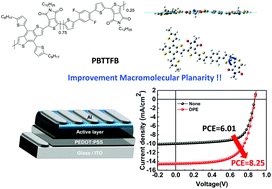Highly efficient polymer solar cells with a thienopyrroledione and benzodithiophene containing planar random copolymer†
Abstract
We synthesized and characterized a new low band-gap copolymer, PBTTFB, incorporating N-alkylthieno[3,4-c]pyrrole-4,6-dione (TPD) as the acceptor and benzodithiophene (BDT) and (2,5-difluorophenylene)dithiophene as the donor units with S⋯F and S⋯O non-covalent intramolecular interactions. The PBTTFB polymer replaced bis(dodecyloxy)benzo[c][1,2,5]thiadiazole (BT) in P1, a previously reported polymer, with 5-dodecyl-4H-thieno[3,4-c]pyrrole-4,6(5H)-dione and exhibited improved macromolecular planarity and molecular ordering of the molecular structure. UV-vis absorption, electrochemical properties, bulk-heterojuction (BHJ) film morphology, and molecular ordering as well as photovoltaic charaterization derived from PBTTFB were studied and analyzed to explore the effect of the thienopyrroledione unit instead of the benzodithiophene unit in the molecular backbone of the polymer. From photovoltaic charaterization, we obtained an enhanced Jsc value of 14.51 mA cm−2 from the PBTTFB polymer compared to the Jsc value of 10.54 mA cm−2 from P1 due to improved macromolecular planarity. Furthermore, PBTTFB exhibited the highest PCE of 8.25% by adding DPE as a processing additive due to better interpenetration networks for improving charge transport and collection.



 Please wait while we load your content...
Please wait while we load your content...